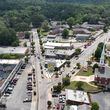Like many people, I’m thrilled that MARTA buses are now rolling in Clayton County. People use transit to get to work, schools, hospitals and shopping – so this is a big boost to the region’s economy and quality of life.
Nearly three-fourths of transit trips in the Atlanta region begin with walking trips. So for transit to be successful, people need more than buses. They also need safe routes to bus stops.
Without safe crossings, walking to transit can be deadly. Nearly half of all pedestrian-vehicle crashes in the Atlanta region occurred within 300 feet of transit stops.
Eager to see with my own eyes how safely people can walk to transit stops in Clayton County, I hopped on the bus at the College Park station. Service was excellent and on time. A friendly driver welcomed a bus packed with new riders. She passed out route maps and schedules.
Route 196 traverses Riverdale Road, Jonesboro Road and Tara Boulevard. A recent analysis of federal figures by Smart Growth America identified these as the county’s most dangerous places to walk. Over 40 people were killed while walking on these roads during the past decade. So for people who walk to bus stops in Clayton County, the challenge is huge.
Jonesboro Road lacks sidewalks, and crosswalks are nearly a mile apart. To cross the street, people have to navigate fast-moving traffic and a drainage ditch. Tara Boulevard has 10 lanes, which makes it especially dangerous. Traffic there was heavy, and an older woman I saw standing on a raised strip of concrete in the middle of the road had a difficult time finding a safe gap to finish crossing
While on the bus, I talked to other passengers. James Brooks said he’s glad to have the new bus service. But for him, crossing the street isn’t the only safety issue. Even worse, many areas lack street lights. “It doesn’t feel safe walking after getting off the bus at night.”
Most pedestrians struck by vehicles are hit in urban areas, where people walk more. Yet people struck in suburban areas are more likely to be killed. The combination of wide roads, high speeds, infrequent crosswalks and missing sidewalks often has tragic outcomes.
Pedestrians account for over one out of four traffic fatalities in Clayton County. In Georgia, this is second only to DeKalb County. Many people in the Atlanta region live and travel in places built for high-speed automobiles. We need to adapt to the new reality.
People who walk have a right to cross roads safely. This is especially important on transit corridors. With the introduction of bus service, increased investment in safe crossings is one of Clayton County’s greatest needs.
Agencies that design and operate roads have many options for increasing pedestrian safety. Placing safe crossings close to bus stops increases the likelihood that people will use them. Even simple improvements – like the median refuge islands installed recently on Buford Highway – make a big difference for people who walk. Better street lighting and high-tech beacons also help. No driver wants to hit someone, so changes like these benefit everyone, not just people on foot.
An issue we hear about frequently – cost – is not the real barrier. Transportation agencies spend millions each year. The real issue is how they use it.
Long-awaited fixes to the notoriously brutal Buford Highway are now under construction. Much more is needed — and much more is possible. The Georgia Department of Transportation received $227 million in federal transportation dollars designated for traffic safety from 2009 – 2013. An analysis of federal figures by the Safe Routes to School National Partnership found, however, that GDOT spent little of that money to fix dangerous conditions for people on foot.
Changes won’t happen overnight. PEDS, an organization dedicated to making the Atlanta region a great place to walk, is working with MARTA, neighborhood activists and other stakeholders to identify dangerous locations and recommend solutions. City, county and state agencies have the authority and responsibility to implement safety improvements. We can, should and must work together and get the job done.
Creating safe routes to transit in the Atlanta region is easier said than done. But by working together and taking actions needed to install safe crossings, we will make it far safer for people in Clayton County to walk to transit.





